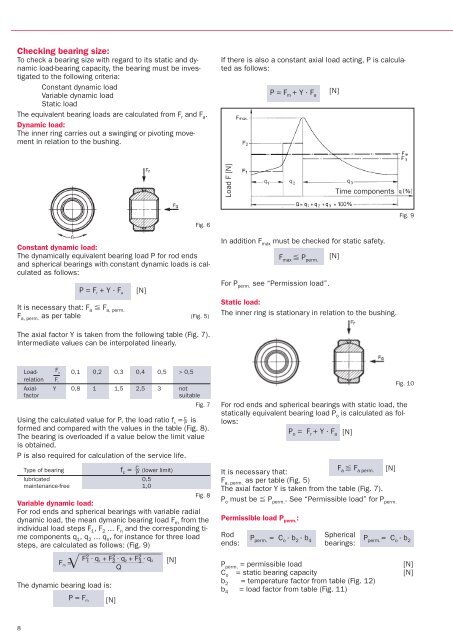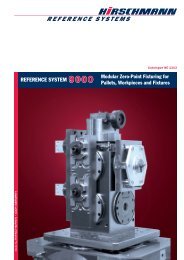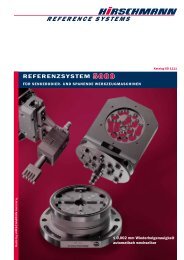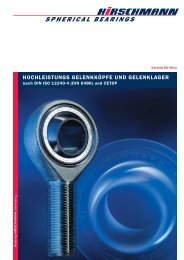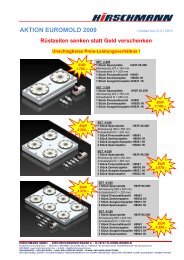heavy-duty rod ends and spherical bearings - Hirschmann GmbH
heavy-duty rod ends and spherical bearings - Hirschmann GmbH
heavy-duty rod ends and spherical bearings - Hirschmann GmbH
You also want an ePaper? Increase the reach of your titles
YUMPU automatically turns print PDFs into web optimized ePapers that Google loves.
Checking bearing size:<br />
To check a bearing size with regard to its static <strong>and</strong> dynamic<br />
load-bearing capacity, the bearing must be investigated<br />
to the following criteria:<br />
Constant dynamic load<br />
Variable dynamic load<br />
Static load<br />
The equivalent bearing loads are calculated from F r <strong>and</strong> F a .<br />
Dynamic load:<br />
The inner ring carries out a swinging or pivoting movement<br />
in relation to the bushing.<br />
8<br />
Fig. 6<br />
Constant dynamic load:<br />
The dynamically equivalent bearing load P for <strong>rod</strong> <strong>ends</strong><br />
<strong>and</strong> <strong>spherical</strong> <strong>bearings</strong> with constant dynamic loads is calculated<br />
as follows:<br />
It is necessary that: F a F a, perm.<br />
F a, perm. as per table (Fig. 5)<br />
The axial factor Y is taken from the following table (Fig. 7).<br />
Intermediate values can be interpolated linearly.<br />
[N]<br />
Load- Fa relation Fr 0,1 0,2 0,3 0,4 0,5 > 0,5<br />
Axial- Y 0,8 1 1,5 2,5 3 not<br />
factor suitable<br />
Fig. 7<br />
Using the calculated value for P, the load ratio f c = C__ P is<br />
formed <strong>and</strong> compared with the values in the table (Fig. 8).<br />
The bearing is overloaded if a value below the limit value<br />
is obtained.<br />
P is also required for calculation of the service life.<br />
Type of bearing fc = C__ P (lower limit)<br />
lubricated 0,5<br />
maintenance-free 1,0<br />
Fig. 8<br />
Variable dynamic load:<br />
For <strong>rod</strong> <strong>ends</strong> <strong>and</strong> <strong>spherical</strong> <strong>bearings</strong> with variable radial<br />
dynamic load, the mean dymanic bearing load Fm from the<br />
individual load steps F1, F2 ... Fn <strong>and</strong> the corresponding time<br />
components q1, q2 ... qn, for instance for three load<br />
steps, are calculated as follows: (Fig. 9)<br />
F m =<br />
P = F r + Y · F a<br />
The dynamic bearing load is:<br />
<br />
P = F m<br />
F2 1 · q1 + F2 2 · q2 + F2 3 · q _____________________________ 3<br />
Q<br />
[N]<br />
[N]<br />
If there is also a constant axial load acting, P is calculated<br />
as follows:<br />
Load F [N]<br />
[N]<br />
In addition F max must be checked for static safety.<br />
For P perm. see “Permission load”.<br />
[N]<br />
Static load:<br />
The inner ring is stationary in relation to the bushing.<br />
Fig. 9<br />
Fig. 10<br />
For <strong>rod</strong> <strong>ends</strong> <strong>and</strong> <strong>spherical</strong> <strong>bearings</strong> with static load, the<br />
statically equivalent bearing load Po is calculated as follows:<br />
Po = Fr + Y · Fa [N]<br />
F<br />
It is necessary that:<br />
a Fa perm. [N]<br />
Fa, perm. as per table (Fig. 5)<br />
The axial factor Y is taken from the table (Fig. 7).<br />
Po must be Pperm.. See “Permissible load” for Pperm. Permissible load P perm.:<br />
Rod<br />
P<br />
Spherical<br />
perm. = Co · b2 · b4 <strong>ends</strong>: <strong>bearings</strong>:<br />
Pperm. = permissible load [N]<br />
Co = static bearing capacity [N]<br />
b2 = temperature factor from table (Fig. 12)<br />
= load factor from table (Fig. 11)<br />
b 4<br />
P = F m + Y · F a<br />
F max P perm.<br />
Time components<br />
P perm. = C o · b 2


